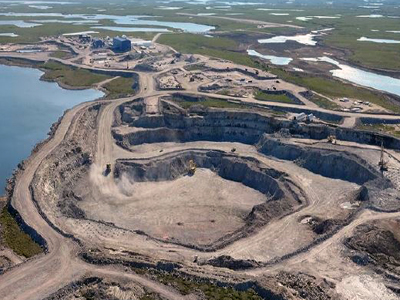Gahcho Kué partners hope to extend the mine well past its 12-year projection.
Self-congratulation might have been irresistible as 150 visitors from across Canada and the world flocked to a spot 280 kilometres northeast of Yellowknife to attend Gahcho Kué’s official opening on September 20. But there’s no evidence the mining and exploration crowd will waste much time resting on their laurels. JV partners De Beers and Mountain Province Diamonds TSX:MPV continue their pursuit of additional resources. And within sight of the Northwest Territories’ new mine, Mountain Province spinout Kennady Diamonds TSXV:KDI hopes success will repeat itself right next door.
Twenty-one years in the making and the world’s largest new diamond mine in 13 years, Gahcho Kué’s expected to give up 54 million carats over a 12-year lifespan. Average price estimates for the three pipes come to $150 per carat. That would provide Canada with gross value added benefits of $6.7 billion, $5.7 billion of that going to the NWT, which would gain nearly 1,200 jobs annually, according to an EY study released earlier this month.
That’s a strong rebound for the territory’s biggest private sector industry, following last year’s shutdown of the Cantung Tungsten mine and De Beers’ Snap Lake. The closures left the NWT with just two mines, both diamond operations in the Lac de Gras region that also hosts the newcomer.
But those two mines, theRio Tinto NYSE:RIO/Dominion Diamond TSX:DDC 60/40 JV at Diavik and Dominion’s majority-held Ekati, maintained Canada’s place as the world’s third-largest producer by value.
Holding 51% and 49% respectively of Gahcho Kué, De Beers and Mountain Province hope to prolong its duration. Rather expansively maybe, the slightly junior partner outlines a multi-phase program.
Should all go to plan, Phase II would upgrade resources into reserves, maybe adding as much as five years to the operation. Phase III would deepen the Tuzo pipe, bringing another three years. Phase IV would do the same to the 5034 and Hearne kimberlites, as well as bring on the new Tesla pipe. If plans, projections and prayers come to fruition, Gahcho Kué might end up with more than 20 years of operation. With optimism drowning out any puns regarding pipe dreams, Phase V calls for “new targets.”
At least that’s the tale told by Mountain Province. De Beers acts as project operator.
Another company also holds high hopes, as well as about 71,000 hectares to the north, west and south of Gahcho Kué. Mountain Province spun out the Kennady North project into Kennady Diamonds, which has been advancing its own ambitious timeline.
The project’s Kelvin kimberlite has a maiden resource slated for this quarter and a PEA for Q4. Subject to those results, the company hopes to take Kelvin to feasibility next year, and to complete resource estimates for the Faraday 1, 2 and 3 kimberlites less than three kilometres northeast.
On the eve of the Gahcho Kué grand opening, Kennady pronounced itself pleased with this year’s 612-tonne bulk sample recovery, averaging 2.09 carats of commercial-sized stones per tonne from Kelvin’s north limb. With last year’s south limb grade coming to 2.02 carats per tonne, the results show “remarkable consistency in overall diamond grade across the full extent of the body,” said president/CEO Rory Moore. “This is a positive attribute from both an evaluation and a mining perspective.”
In a crucial step, a parcel goes to Antwerp next month for a price evaluation, with results expected about three weeks later.

Two rigs currently have the Faraday kimberlites subject to an 8,000-metre summer program of both exploration and delineation drilling. Out of 15 holes reported so far, 14 revealed kimberlite.
The summer program follows a 10,712-metre winter campaign that discovered Faraday 3 as well as four diamonds in drill core, two each from Faradays 1 and 3.
Two mini-bulk samples released this year for Faraday 1 averaged 4.65 carats per tonne and three carats per tonne respectively. Faraday 2 minis averaged 2.69 carats, 3.04 carats and 4.48 carats per tonne.
Last month Kennady expanded its property by another 4,233 hectares directly south of Gahcho Kué. But the company’s focus remains on the Kelvin-Faraday corridor north of the new mine.
As for De Beers, its other Canadian focus since Snap Lake’s demise has been the Victor mine in Ontario’s James Bay region. With less than five years of operation left, it too faces doom. Another seven years could potentially come from the Tango kimberlite, seven kilometres away and now undergoing a federal environmental review.
Local relations, however, have taken an unexpected turn. Last week De Beers Canada chief executive Kim Truter told CBC the company would go beyond the duty to consult and seek the Attawapiskat community’s outright consent for Tango. “It’s pointless us actually operating in these first nations areas if we don’t have local support,” he said.
The network added, “Support has been shaky in the first nation since the signing of the original agreement with De Beers in 2005. Band officials boycotted and picketed the grand opening of the mine in 2008 and the road into the mine has been blockaded several times, including in 2013.”
But Truter’s remarks drew an angry response from newly elected chief Ignace Gull, the Timmins Press reported September 19. The paper quoted a social media post in which he stated, “Attawapiskat is in a midst of suicide crisis and we need to deal with this first and they have to back off instead of threatening us.”
In Quebec’s James Bay region, Stornoway Diamond TSX:SWY began ore processing at its Renard project in July, expecting to achieve commercial operation by year-end. The province’s first diamond mine expects to average 1.6 million carats annually for an initial 14 years.
Back at Gahcho Kué, visitors celebrated the grand opening as a possible strike loomed. Last week CBC reported that mediation had broken down between a contractor and a Teamsters local representing around 60 camp kitchen and cleaning staff.

